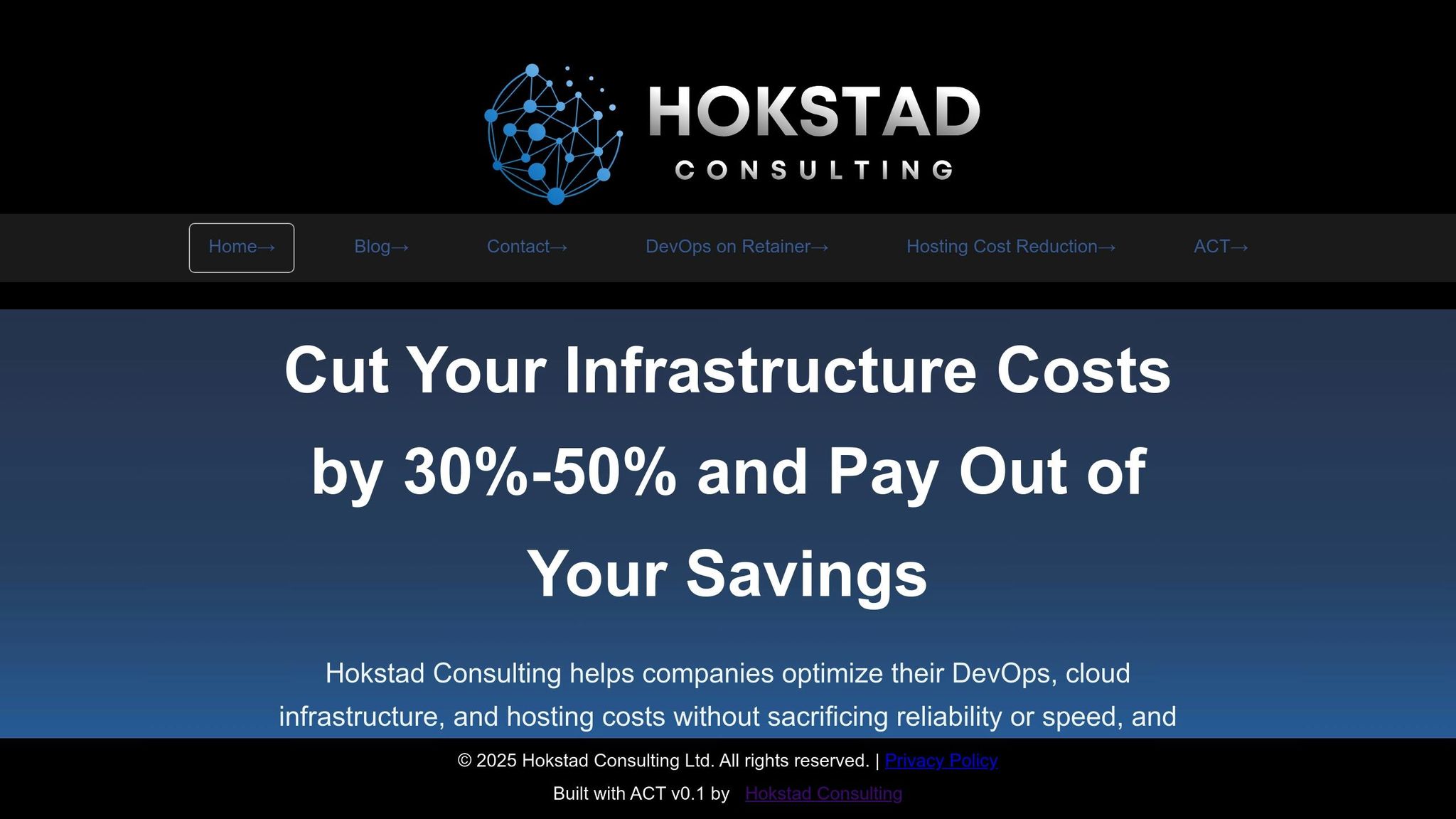Encryption isn't optional under GDPR - it’s mandatory. DevOps teams must secure personal data with strong encryption at every stage of development to comply with GDPR and avoid fines of up to £17.5 million or 4% of global turnover. Here's what you need to know:
- Encryption is required for data at rest and in transit. AES-256 is recommended for stored data, while HTTPS/SSL is essential for transmissions.
- Key management is critical. Secure storage, regular key rotation, and strict access controls are non-negotiable.
- Testing and monitoring are ongoing responsibilities. Regular audits, breach simulations, and automated compliance checks ensure encryption remains effective.
- GDPR compliance impacts workflows. DevOps teams must integrate encryption into CI/CD pipelines, development environments, and deployment processes.
What Are Best Practices For Data Encryption Compliance? - Cloud Stack Studio

GDPR Encryption Requirements for DevOps Teams
For DevOps teams, navigating GDPR's encryption requirements is a balancing act between safeguarding personal data and maintaining smooth operational workflows. While GDPR doesn't prescribe specific encryption algorithms, it expects organisations to use advanced
measures tailored to the level of risk and the specific context[6]. This flexibility allows teams to select encryption methods that align with their systems and the sensitivity of the data they handle.
At its core, GDPR demands that personal data be unreadable without the correct decryption keys. This principle must be woven into every stage of the development and deployment process. By adopting these technical measures, teams align with GDPR's broader compliance goals. Let's explore how these requirements translate into practical steps.
Encryption at Rest and in Transit
Protecting data requires a dual strategy: safeguarding it both when stored and during transmission. For data at rest - whether in databases, file systems, or backups - the Advanced Encryption Standard (AES) is a widely recommended choice. AES-256 is the gold standard, although AES also offers 192-bit and 128-bit options for scenarios where lower security levels might suffice[4]. To ensure integrity and confidentiality, encryption should operate in Cipher Block Chaining (CBC) mode or an even more secure mode.
When it comes to data in transit, HTTPS/SSL protocols are a must to shield it from interception or tampering as it moves between systems, services, or APIs[5]. Industry best practices dictate that encryption should be consistently applied across all storage and transmission points to prevent vulnerabilities[2]. However, encryption alone isn't enough - it must be paired with robust key management, as discussed next.
Key Management Practices
The security of encryption hinges on how well encryption keys are managed. Keys must be stored securely, not left in code or configuration files, and access should be strictly limited using role-based access controls and the principle of least privilege[2][3]. Zero-knowledge encryption protocols add another layer of security by ensuring that only authorised personnel can access keys, with the infrastructure itself remaining unaware except during controlled operations[4].
Regularly rotating encryption keys reduces the risk of exposure if a key is compromised. Documenting key usage and access is equally important, as it provides an audit trail essential for compliance verification[2]. Many DevOps teams turn to cloud-native key management tools like AWS KMS or Azure Key Vault. These solutions offer centralised storage, automated key rotation, and seamless integration with DevOps workflows, simplifying compliance efforts[1].
Data Breach Notification Compliance
Encryption plays a critical role in GDPR's data breach notification rules. Organisations are generally required to inform affected individuals and regulators of breaches within 72 hours. However, if personal data is encrypted and rendered unreadable to unauthorised parties, this obligation could be reduced - or even waived entirely[6]. That said, this protection is only valid if encryption is properly implemented and maintained throughout the data lifecycle.
To ensure compliance, DevOps teams should enforce encryption consistently across all systems. Regular testing, monitoring, and automated breach detection systems are essential. These tools not only help detect security issues but also enable teams to act quickly, meeting GDPR's stringent timelines. By integrating encryption deeply into workflows, DevOps teams can create a more secure and compliant environment.
Adding Encryption to DevOps Workflows
To effectively integrate encryption into DevOps workflows, it’s crucial to build it directly into existing pipelines rather than treating it as an afterthought. This ensures compliance with GDPR regulations while maintaining the speed and reliability that modern development teams rely on.
Adding Encryption to CI/CD Pipelines
Incorporating encryption into CI/CD pipelines starts with pinpointing every stage where personal data is handled. This includes build artefacts, environment variables, database connections, and API communications. By embedding encryption tasks into pipeline scripts, sensitive data can be safeguarded at every step.
For example, implementing secret masking and automated key rotation during builds helps prevent accidental data exposure. Tools that encrypt files and environment variables automatically during the build process minimise human error without slowing down deployment. Using infrastructure-as-code allows you to enforce encryption measures on cloud resources, while automated policy scanning can identify compliance issues before deployment.
This approach ensures encryption becomes a consistent and seamless part of your development pipeline.
Encryption Across Development Environments
Encryption shouldn’t just be a priority in production environments. Extending the same level of security to development and staging environments is essential to avoid vulnerabilities that could lead to data breaches or non-compliance.
Standardising encryption protocols, such as using AES-256 across all environments, ensures uniform protection. Centralised key management simplifies the process of safeguarding personal data and auditing key access across systems.
By leveraging configuration as code, encryption requirements can be encoded directly into deployment definitions. This prevents configuration drift and ensures that security policies are automatically applied across all environments. Regular audits and automated compliance checks are vital to confirm that encryption settings remain intact and properly configured over time.
Testing and Validating Encryption Setups
Given GDPR’s stringent encryption requirements, regular testing and validation are non-negotiable. Automated security testing tools should verify that encryption is active across all data stores and network connections. These tools can simulate breaches to confirm that encryption measures are robust enough to withstand attacks. For accurate results, test environments should closely mirror production setups.
Penetration testing adds another layer of scrutiny by simulating targeted attacks designed to exploit potential weaknesses in encrypted data.
Continuous compliance scanning further strengthens your security posture by offering ongoing verification that encryption practices align with GDPR standards. These tools can automatically generate reports detailing encryption status, simplifying audit preparations. Regular testing and validation ensure that encryption measures remain effective as your systems evolve.
Need help optimizing your cloud costs?
Get expert advice on how to reduce your cloud expenses without sacrificing performance.
Monitoring and Auditing Encryption for GDPR
When encryption becomes part of DevOps workflows, keeping an eye on its performance and maintaining thorough audits is vital for GDPR compliance. These processes ensure you can demonstrate adherence to regulations while confirming that encryption remains effective over time.
Real-Time Monitoring of Encryption Status
Real-time monitoring helps you spot encryption issues as they happen. Automated systems can be set up to confirm encryption is active across all data stores, network connections, and environments.
Key metrics to track include the percentage of encrypted data, certificate validity, and how often encryption keys are rotated. Monitoring these metrics allows teams to quickly address any issues that arise.
Tools like SIEM platforms - such as Splunk or Azure Sentinel - integrate seamlessly with DevOps pipelines, delivering instant alerts when encryption fails or anomalies are detected. Dashboards displaying metrics, like 99.8% of data encrypted with valid certificates, provide strong evidence during audits. Additionally, automated monitoring can detect unexpected changes in encryption settings across development, testing, and production environments. This ensures teams can act swiftly to address vulnerabilities [3].
These proactive monitoring efforts also create a solid foundation for detailed audit trails.
Creating and Managing Audit Trails
GDPR compliance demands thorough documentation of all encryption-related activities. Audit trails should capture who accessed or modified encryption keys, when these actions occurred, and the context behind them.
Centralised, immutable logging systems with cryptographic hashes and strict access controls are essential for recording every encryption key access and change.
Platforms like the ELK Stack or Azure Monitor can consolidate logs from various sources, simplifying the process of producing evidence during audits. These platforms track key events such as key generation, rotation, and access changes across your infrastructure. Given the UK’s requirement to retain audit evidence for six years, it’s also wise to conduct periodic reviews - monthly if possible - to ensure logs remain accurate and complete [1][5].
Each log entry should detail user identity, timestamps, actions taken, affected systems, and the business justification. This level of detail not only demonstrates that encryption controls are working but also helps identify potential security gaps.
With detailed audit trails in place, automated reporting can streamline compliance verification further.
Automated Compliance Reporting
Manually preparing compliance reports can be error-prone and time-consuming. Automated systems simplify this process by generating regular, tailored summaries of encryption status, audit trail completeness, and any issues detected.
These platforms can produce reports summarising encryption coverage, incident responses, and key rotations. This ensures rapid detection of breaches, which is critical for meeting GDPR's 72-hour notification requirement.
Reports can be customised to align with specific audit needs, providing clear summaries of encryption practices, incident handling metrics, and evidence of routine key rotations. Automated systems also enable monitoring tools to detect potential breaches and trigger immediate alerts, helping organisations stay compliant [2].
Regular compliance scans ensure encryption practices remain aligned with GDPR standards. By delivering detailed reports, these tools make audit preparation less stressful and keep your organisation ready for regulatory scrutiny.
Experts agree that integrating monitoring and auditing into DevOps workflows not only strengthens security but also boosts operational efficiency. This allows teams to focus on driving innovation while staying firmly within GDPR compliance [1][2][4].
How Hokstad Consulting Supports GDPR-Compliant Encryption

Implementing GDPR-compliant encryption in DevOps requires a well-thought-out strategy. Hokstad Consulting combines expertise in DevOps transformation, cloud cost management, and security improvements to help UK businesses achieve strong encryption without sacrificing efficiency. Here's how they approach automation, cost management, and ongoing compliance to meet GDPR standards.
DevOps Transformation with Automated Encryption
Hokstad Consulting integrates encryption directly into the CI/CD pipeline, ensuring personal data is encrypted both at rest and during transit with GDPR-compliant protocols [2][3]. Instead of treating encryption as an afterthought, they make it an essential part of the deployment process.
They automate tasks such as encryption, secret management, and security scans, embedding compliance as code
into deployment pipelines. By using AES-256 encryption, custom key management, and zero-knowledge protocols, they limit access to sensitive data [4].
This automation aligns with the growing demand for compliance as code
, where regulatory requirements are integrated into infrastructure and deployment scripts. This ensures encryption and other controls are automatically enforced and validated [2][7]. The result? A development environment where GDPR compliance is seamlessly woven into the workflow.
Automating compliance processes can save DevOps teams up to 60% of the time they’d otherwise spend on manual audits [2][7]. For UK businesses working within tight budgets, this time-saving approach allows teams to focus more on delivering projects and driving innovation.
Cloud Cost Engineering for Encryption Efficiency
A major concern for businesses implementing encryption at scale is the cost. Hokstad Consulting addresses this by applying cloud cost management techniques to optimise encryption efficiency. They focus on cost-effective encryption methods, automated resource scaling, and leveraging cloud-native encryption services to minimise expenses.
Their strategy includes analysing usage patterns to avoid duplicating encrypted data unnecessarily and recommending multi-tenant architectures with privilege-based access controls. These measures help reduce operational costs without compromising security [4]. For UK clients, savings are calculated in pounds sterling (£) and tailored to local cloud pricing models.
One case study revealed a 30% reduction in encryption-related costs while maintaining full GDPR compliance. This demonstrates Hokstad Consulting's ability to balance financial constraints with regulatory demands, which is vital for businesses in competitive industries.
In addition, their expertise extends to selecting encryption standards that align with GDPR's requirement to make personal data unreadable in the event of a breach [4][6]. This ensures clients invest in solutions that deliver maximum protection for every pound spent.
Compliance Audits and Security Optimisation
Staying GDPR-compliant isn't a one-time effort - it requires constant monitoring and regular updates. Hokstad Consulting provides ongoing compliance audits to review encryption setups, access controls, and data flows, ensuring businesses remain aligned with GDPR requirements.
They use automated tools to detect policy violations, conduct Privacy Impact Assessments (PIAs), and generate compliance reports formatted for UK regulatory reviews. These reports include details like DD/MM/YYYY dates and 24-hour time formats, making them ready for local authorities.
Hokstad Consulting also ensures continuous compliance by maintaining audit trails for key usage and access events, as required by GDPR [2][4]. They extend key management practices and automated testing to adapt to evolving DevOps workflows, cloud infrastructures, and regulatory changes.
Their team highlights common challenges such as managing encryption across multiple environments, automating key rotation without disrupting services, and balancing costs with compliance. Their solutions focus on early integration of encryption into CI/CD pipelines, regular compliance checks, and leveraging cloud-native security features to address these challenges effectively [2][3][4].
Meeting GDPR Encryption Standards
Ensuring encryption aligns with GDPR in DevOps means striking the right balance between security, efficiency, and regulatory requirements. This involves using strong encryption protocols for both data at rest and data in transit, all while maintaining the flexibility needed for agile development.
DevOps teams are required to safeguard personal data by implementing AES-256 encryption consistently across development, testing, and production environments, as stipulated by GDPR regulations[2].
Failing to comply can lead to hefty penalties, including fines of up to £17.5 million or 4% of a company’s annual global turnover[6]. Beyond financial consequences, organisations may also face reputational harm and increased regulatory scrutiny.
To meet these standards, continuous monitoring and automated compliance reporting are essential. Real-time systems can detect unauthorised access, while detailed audit trails ensure adherence to GDPR's 72-hour breach notification rule[2]. Advanced encryption techniques, such as zero-knowledge encryption, add an extra layer of security by ensuring only authorised personnel can access sensitive keys[4].
Seamlessly integrating these encryption standards into daily workflows is key to maintaining operational efficiency. For businesses in the UK, expert support can make a significant difference. Hokstad Consulting, for instance, specialises in DevOps transformation and cloud cost engineering, helping organisations embed encryption into CI/CD pipelines while keeping costs under control.
Automated compliance tools now make it possible to incorporate regulatory controls directly into DevOps workflows. By embedding these controls, businesses can ensure GDPR compliance becomes an integral part of their development process, reinforcing security and efficiency at every stage.
FAQs
How can DevOps teams integrate encryption into their CI/CD pipelines to meet GDPR compliance?
To align with GDPR regulations, DevOps teams need to embed encryption into their CI/CD pipelines. The first step is pinpointing sensitive data that requires protection. Ensure encryption at rest and encryption in transit are applied to safeguard this data. Opt for robust encryption standards like AES-256, and prioritise secure management of encryption keys.
Automating encryption processes within the pipeline is crucial to reducing the risk of human error. Consider integrating tools that automatically encrypt data during deployments or when moving data between environments. Regular reviews and testing of encryption practices are essential to uncover vulnerabilities and confirm compliance with GDPR.
Incorporating encryption at every stage of your CI/CD pipeline not only enhances data security but also keeps your operations in line with GDPR standards.
What challenges do DevOps teams face with encryption key management under GDPR, and how can they address them?
Managing encryption keys within the framework of GDPR presents a unique set of challenges for DevOps teams. Ensuring these keys are stored securely, preventing unauthorised access, and adhering to proper key rotation policies are all critical tasks. Why? Because the way encryption keys are managed has a direct impact on both data security and regulatory compliance.
To tackle these challenges, teams should consider adopting centralised key management systems. These systems simplify operations and enhance security by consolidating key management processes. Automating key rotation and access controls is another smart move, as it minimises human error and helps align with GDPR requirements. Finally, conducting regular audits and continuous monitoring is crucial. These practices help spot vulnerabilities early and support strong encryption protocols.
How do real-time monitoring and automated compliance reporting support GDPR compliance for DevOps teams?
For DevOps teams, staying aligned with GDPR regulations is no small feat. This is where real-time monitoring and automated compliance reporting step in as indispensable allies. These tools work tirelessly to keep an eye on system activity, flagging potential data breaches or compliance issues as they happen. This proactive approach allows teams to tackle risks head-on before they spiral out of control.
Automated compliance reporting takes the headache out of proving GDPR adherence. It generates detailed, up-to-date reports that showcase encryption practices, data access controls, and other key compliance measures. These reports not only streamline audits and regulatory reviews but also save valuable time and effort.
By weaving these tools into their daily workflows, DevOps teams can prioritise delivering top-notch solutions without compromising on strong data protection practices.
